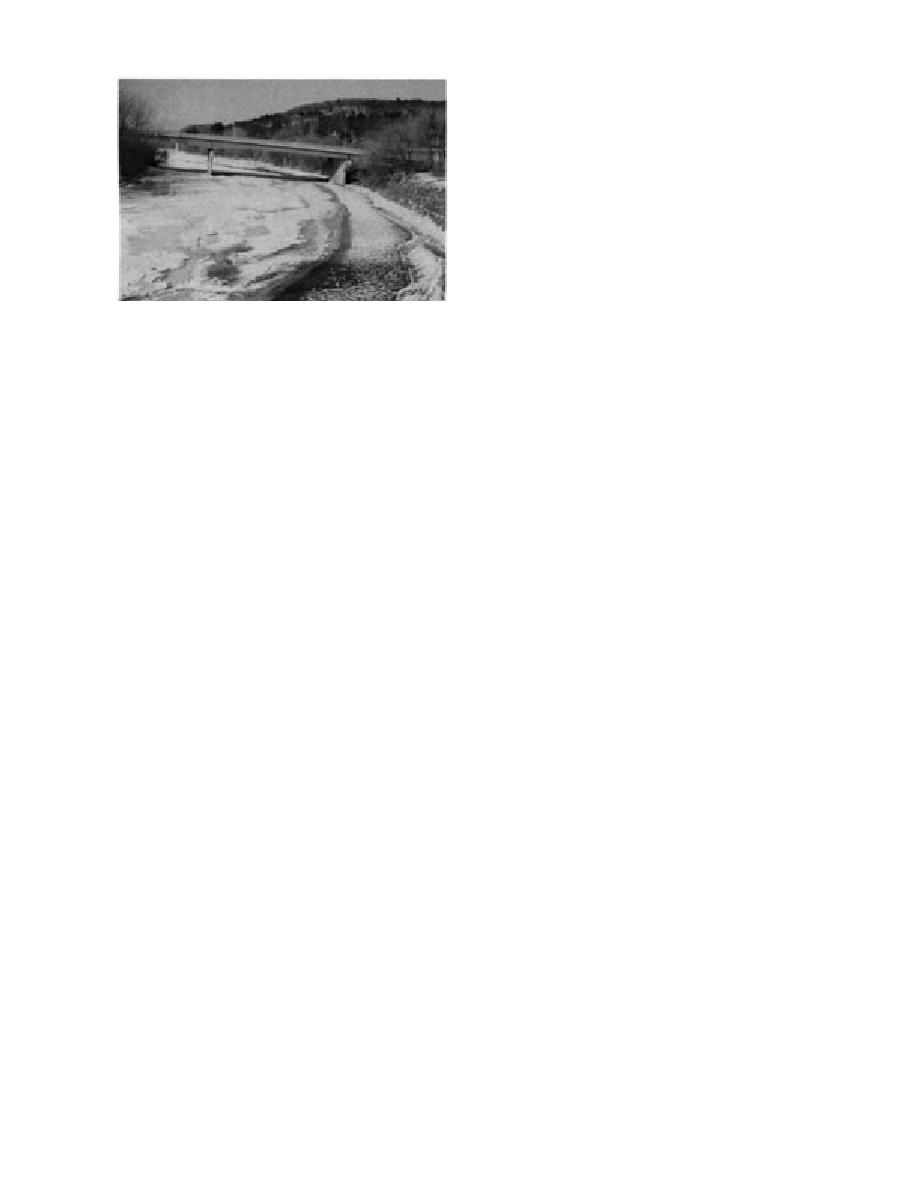
other parameters affecting the process are identi-
fied. Other necessary instrumentation to mea-
sure ice thickness and ice velocity using radar
technology is also under development at CRREL
(Yankielun 1992).
The differences in the focal points (ice forces
and scour) are reflected in the types of instru-
mentation deployed on the two bridges. The two-
bridge approach has the added benefit of moni-
toring the effect that 2000 ft of river and ice has
on the system hydraulics.
A long-range objective is to develop computer-
based data acquisition systems to monitor river
hydraulic parameters. The programs are event-
Figure 7. Route 5 bridge, February 1992, showing ice
driven, with on-site display of the data. This will
conditions upstream of the instrumented bridge.
enable researchers to correlate the measurements
with the physical processes. The detail, accuracy
The lower reach of the White River has a his-
and number of parameters incorporated into the
tory of ice jams and scour, which, in addition to
data acquisition package are expected to evolve
being close to CRREL, makes the site ideal for
as a function of instrumentation required to en-
studying ice forces and scour. With the new bridge
hance our understanding or documentation of
in the design stage, instrumentation and cable
the hydraulic and ice force phenomena. Natu-
raceways could economically be incorporated into
rally the rate of implementation is subject to fund-
the design with only a slight increase in con-
ing availability.
struction cost. Ideally both the scour and the ice
forces should be measured on the same pier. But
Ice forces
with scour being recognized as the primary cause
There have been several efforts to measure in-
of failure of the former bridges, the piers of the
situ the forces exerted by ice on bridge piers
new Bridge Street bridge were designed with
(Sodhi et al. 1983, Haynes et al. 1991). In such
riprap scour protection, so the installation of in-
studies, the force measurement instruments had
strumentation to measure scour near the new
to be retrofitted on existing bridge piers or incor-
piers would be fruitless. However, approximately
porated into new construction. The construction
2000 ft upstream of the new bridge, U.S. Route 5
of the new bridge in White River Junction in 1990
crosses the White River (Fig. 7). Built in the 1960s
offered another opportunity to include the ice-
the piers are not protected by riprap, are easily
force monitoring system in the early design stage
accessible during low water, and are ideal for
of the bridge.
evaluating scour instrumentation. The only site
limitation is a backwater effect around both bridges
Ice force panel
from the confluence with the Connecticut River,
Ice forces are measured using a 4-ft-wide, semi-
which is influenced by releases from a 40-mW-
circular beam, attached to the upstream face of
peaking hydroelectric dam upstream on the Con-
the northern bridge pier using a three-point sup-
necticut River in Wilder, Vermont.
port system (Fig. 8). The beam is a built-up
weldment, with the primary elements being two
concentric 1/2-in. steel plates that are intercon-
INSTRUMENTATION
nected using 6-in.-deep channels along the axis
of the 16-ft-long beam (Fig. 9). The weldment's
The objective of installing the instrumentation
cross-section has a high moment of inertia and,
is to remotely collect in-situ field measurements
when combined with properties of high-strength
of hydraulic parameters that affect or are affected
steel used for fabrication, results in a very rigid
by ice. The focal points of the research efforts are
structure. Consequently there is little deflection
ice forces on structures and ice-induced bed ero-
under impact loading. The bottom corners of the
sion and scour. Instrumentation used to docu-
beam are connected via pillow block bearings to
ment these phenomena are expected to evolve as
a common 2.75-in.-diameter stainless-steel pivot
our understanding of the processes improves and
shaft passing through the concrete pier just be-
5



 Previous Page
Previous Page
